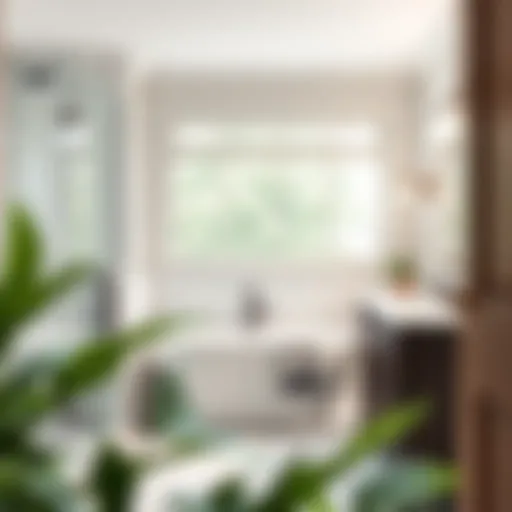Solid Surface Bathroom Countertops: Design & Durability


Intro
When it comes to bathroom renovation, one of the most impactful choices revolves around the countertop material. Solid surface countertops, known for their seamless and versatile design, offer a compelling mix of aesthetics and functionality. This guide seeks to unpack the myriad aspects of solid surface bathroom countertops—covering everything from their design potential to durability and maintenance, ensuring homeowners, designers, and DIY enthusiasts can navigate their options wisely.
The Appeal of Solid Surface
Solid surface materials gain their popularity from their durability and design versatility. Options like Corian and Avonite are not just a pretty face; they provide a range of colors, patterns, and textures, easily mimicking natural stone without the hefty price tag or upkeep.
The pursuit of beauty in the bathroom can take many forms. It’s not just about what looks good, but also how well it holds up against time and wear. This guide will explore options available in solid surface, paving the way for informed decisions in creating spaces that reflect personal style while also ensuring longevity.
In this article, we will dive into three key areas:
- Furniture Design Insights: Here we’ll explore how to incorporate solid surface countertops into various styles and optimize bathroom space.
- Durability: Assessing the toughness of solid surface countertops and how they fare against daily use in humid environments.
- Maintenance and Care: Practical tips for maintaining these beautiful surfaces to keep them looking fresh and new for years to come.
Whether you're flipping a house or simply sprucing up your own home, this exploration aims to equip readers with valuable insights and data-driven choices, making the process of selecting a countertop less daunting and more enjoyable.
Understanding Solid Surfaces
When diving into the world of bathroom design, one can't help but notice the growing inclination towards solid surface materials. This section aims to shed light on what solid surfaces are, providing clarity on their composition, types, and the brands that have made a mark in this sector. With a focus on both aesthetic appeal and practical functionality, understanding the nuances of solid surfaces is key for anyone involved in bathroom design or renovation.
Definition and Composition
Solid surfaces are engineered materials designed to mimic the appearance of natural stone while offering superior functionality. They are primarily composed of acrylics, polyester resins, and sometimes a blend of both, mixed with minerals. This combination yields a non-porous yet durable product, resistant to stains, moisture, and bacteria, making them a common choice for bathrooms.
The beauty of solid surfaces lies in their versatility; they can be molded into various shapes and sizes without seams, which means fluidity in design and ease in installation. Moreover, they maintain a smooth feel and solid look that ensures they stand out in any modern bathroom.
Types of Solid Surface Materials
For a clearer picture, let's take a closer look at the different types of solid surface materials.
Acrylic
Acrylic surfaces are perhaps the most recognized type in this category. They’re lightweight and often easier to work with when custom fabricating, making them popular among homeowners and designers alike. Their non-porous nature helps prevent mold and mildew buildup, which is a pivotal consideration in high-humidity areas like bathrooms. A key characteristic is their vibrant colors and patterns, which can be integral in achieving a specific aesthetic. However, one must be mindful of their susceptibility to scratches; while minor scratches can often be buffed out, deep gouges might require more extensive repairs.
Polyester
Polyester solid surfaces, on the other hand, are known for their glossy finish and affordability. This material tends to be denser and less forgiving than acrylic; which means while it offers beautiful, shiny aesthetics, it may not perform as well in terms of ding resistance. However, polyester offers an extensive range of color options and can be a good choice for budget-conscious renovations. Its vividness of color is certainly a plus, but it can erode faster than acrylic under heavy use.
Composite
Composite solid surfaces bring another layer to the table, combining various elements such as stone and synthetic materials to create a unique blend. This means that they can mimic the look of natural stone while providing improved durability. A remarkable feature of composite surfaces is their balance between weight and durability; they can withstand considerable force without breaking. Nonetheless, they can come with a heftier price tag, which might deter some buyers. Careful consideration here hinges on aesthetics versus budget.
Common Brands and Their Offerings
Several brands dominate the solid surface market, each offering distinct advantages. Popular names like Corian and Hanex have made a name for themselves by providing not only a variety of options in colors and materials but also guarantee long-term durability.
These brands often feature solid surface designs that look seamless and elegant, showcasing their commitment to the aesthetic and functional needs of consumers.
When considering what brand to choose, examining warranties and customer service may give you insight into the reliability of the product.
Understanding the varied aspects of solid surfaces allows homeowners, designers, and DIY enthusiasts to make well-informed decisions. This foundational knowledge paves the way for a design experience that is both enjoyable and successful.
Design Flexibility in Solid Surfaces
Design flexibility is one of the hallmark features of solid surface countertops, enabling homeowners and designers to break free from traditional boundaries of style and functionality. With an ever-growing demand for personalized aesthetics in home design, solid surfaces provide a canvas that can be modified to suit an array of preferences. This section will shine light on how color and pattern options, custom fabrication capabilities, and integration with various materials contribute to the unique attributes solid surfaces bring to bathroom countertops.
Color and Pattern Options
When it comes to solid surface materials, the variety of colors and patterns available is simply astounding. Unlike natural stone, which often comes with inherent flaws and a limited color palette, solid surfaces present an expansive range of hues—from muted pastels to vibrant neons. This capability allows for a personalized touch in each bathroom design.
- Monochrome Masterpieces: Many homeowners opt for single-tone surfaces that deliver a sleek, modern finish. By selecting neutral colors, designers can create a timeless appeal that resonates with a vast audience.
- Patterns Galore: The ability to include speckles, swirls, or even custom designs ensures that the countertops can reflect individual styles, whether that be minimalist, rustic, or something on the avant-garde spectrum.
Not only does this variety cater to aesthetic preferences, but it also permits designers to harmoniously coordinate countertops with other elements in the bathroom, creating a cohesive atmosphere.
Custom Fabrication Capabilities


The process of custom fabrication highlights another advantage of solid surface materials. This refers to the capability of cutting, shaping, and finishing the materials to meet exact specifications. Designers are not merely bound by pre-fabricated cuts and dimensions; rather, they can tailor surfaces to fit unique space requirements, enhancing both aesthetics and functionality.
- Seamless Design: One of the most appealing aspects of custom fabrication is the possibility of achieving a seamless look. With solid surfaces, intricate shapes and detailed cutouts–such as integrated sinks–can be executed beautifully.
- Unique Configurations: If a homeowner dreams of an unusual bathroom layout, solid surfaces can accommodate the vision without compromising functionality. This feature is particularly advantageous for unconventional spaces needing custom solutions.
Integration with Other Materials
The ability to integrate solid surface countertops with other materials broadens the design scope significantly, opening the door to creative blends that are both functional and captivating. By pairing solid surfaces with wood accents or metal fixtures, designers can produce bathrooms that showcase depth and texture.
Wood Accents
Incorporating wood accents alongside solid surface countertops contributes warmth and a touch of nature to the bathroom design. Wood’s character brings an inviting feel that counters the sleekness of solid surfaces, striking a balance between modernity and tradition.
- Natural Appeal: The grain patterns and tones of wood create visual interest while maintaining an earthy connection. A solid surface countertop topped with wooden features could evoke a spa-like environment, appealing to many.
- Durability Concerns: While wood adds charm, it requires meticulous care to avoid moisture damage. Choosing a high-quality, moisture-resistant wood can mitigate potential drawbacks, letting homeowners relish the aesthetic benefits without undue concern.
Metal Fixtures
Metal fixtures can introduce a touch of sophistication and edge when paired with solid surface countertops. Whether it's brushed nickel, bronze, or matte black finishes, the contrast can divert attention to the modernistic vibe of the bathroom.
- Functional Styles: Metal fixtures are often easier to maintain and add an industrial flair that works well with the versatility of solid surfaces. They can be elegantly integrated into the design through faucets, towel bars, and cabinet handles.
- Temperature Variability: One must consider that metals conduct heat; hence correct placement near heat sources or with proper insulation is critical to avoid compromising the integrity of the countertops.
Benefits of Solid Surface Countertops
When it comes to bathroom countertops, few materials can claim the blend of beauty and utility that solid surfaces offer. Understanding why solid surface countertops are a go-to choice for many homeowners, designers, and DIY enthusiasts is essential. Let's delve into the specific benefits that make these countertops a staple in modernized bathroom design.
Durability and Longevity
Solid surface countertops are known for their impressive durability and lifespan. This material can withhold heavy use much better than traditional laminate or even some stone surfaces. One primary reason for this resilience is the way solid surfaces are manufactured. The blend of polymers and acrylics creates a solid piece of material that is resistant to chipping and cracking.
Additionally, solid surface countertops don’t suffer from the same wear and tear that natural stone might experience over time. For instance, a granite countertop can crack if subjected to sudden, sharp temperature changes or impact, whereas solid surfaces handle these incidents with minimal damage. Not only are they built to last, but they often come with warranties extending up to 10 years or more. It’s an investment that pays off in the long run—less frequent replacements mean less hassle for homeowners and designers alike.
Non-Porous Nature and Hygiene
Another compelling advantage of solid surface countertops is their non-porous nature. This feature is particularly relevant in a bathroom setting where moisture levels are typically high. Unlike natural stones which can absorb water, leading to potential bacterial growth or stains, solid surfaces resist moisture. This resistance simplifies cleaning routines and enhances hygiene, making it an ideal choice for families or those prioritizing cleanliness.
In everyday terms, you can spill makeup, soap, or even toothpaste on these surfaces without worrying. A simple wipe down with a mild detergent is usually enough to keep them looking fresh and clean. For anyone who appreciates a sanitary bathroom, solid surfaces present a much friendlier option.
Seamless Appearance
Finally, one of the most aesthetic benefits of solid surface countertops is their seamless appearance. They can be crafted into a variety of shapes and sizes, with joints that are virtually invisible to the naked eye. This seamless look not only creates a polished and modern aesthetic but also contributes to their easy cleaning.
"The beauty of solid surfaces lies in their ability to marry form with function, providing a cohesive, elegant finish to any bathroom design."
When installed, they can incorporate sinks and backsplashes into one continuous piece, eliminating the small gaps often found in traditional installations that can collect grime. This feature appeals to designers aiming for a specific aesthetic or homeowners seeking clean lines and contemporary flair in their bathrooms.
In summary, the durability, hygiene, and aesthetics of solid surface countertops make them a reliable choice for any bathroom design. By considering these benefits, one can make a more informed decision about integrating these countertops into their homes.
Drawbacks to Consider
While solid surface bathroom countertops bring a plethora of advantages, it’s crucial to consider their drawbacks too. Understanding these downsides can aid homeowners and designers in making more informed choices. A thorough knowledge of the limitations associated with solid surfaces greatly enhances budgeting, maintenance preparations, and overall satisfaction with the material.
Cost Implications
When diving into the world of solid surface countertops, it’s important to first address cost. These countertops can be on the pricier side, especially when compared to materials like laminate or certain types of tile. The initial investment can feel heavy on the wallet.
Yet, what one needs to keep in mind is that the longevity and low maintenance requirements can balance out the costs over time. It's a bit of a double-edged sword; you pay more upfront but potentially save down the line with fewer replacements and repairs. Homeowners might find the prices range significantly based on brand and customization options. Expect tags near a few thousand dollars for extensive installations, taking into account labor costs and other elements.
- Customization Costs: Custom shapes and designs can push the price higher, especially if hiring a professional to do the work.
- Labor Costs: If you're leaning toward a professional installation rather than a DIY route, labor costs can escalate quickly.
In short, while the sticker shock might momentarily deter you, thinking long-term about investment returns can change the game.
Susceptibility to Scratches
Next on the list is the susceptibility to scratches. Although solid surfaces are quite resilient, they are not entirely scratch-proof. In a busy bathroom, where items are often dropped or dragged across the surface, scratches can crop up over time. This tends to be more noticeable with darker colors, as lighter hues can often hide minor blemishes better.
Homeowners should consider the types of activities their bathrooms accommodate. A family with small children, for instance, might need to exercise a bit more caution around their solid surfaces than a couple without kids. It can be beneficial to think ahead and even invest in protective pads or mats for high-traffic areas.


The good thing, though, is that many scratches can be buffed out quite easily. With a little bit of sanding or polishing, many minor imperfections can disappear without a trace. This gives solid surfaces an edge over materials that might require full replacement for restoration.
Limited Heat Resistance
Finally, let’s touch upon limited heat resistance. Unlike granite or quartz, solid surface countertops can struggle to withstand high temperatures. Placing a hot pot or pan directly on the surface can lead to deformation or, even worse, permanent damage.
To avoid this pitfall, homeowners should consider using trivets or heat pads whenever placing hot items on these counters. It may seem like an inconvenience, but developing this habit can protect the investment over time.
- Long-term Effects: Prolonged exposure to high heat can lead to visible warping of the material.
- Comparative Advantage: Such vulnerabilities make solid surfaces less favorable when compared to more heat-resistant materials like granite, especially in kitchens where hot pans might frequent.
Installation Process for Solid Surface Countertops
The installation of solid surface countertops is a critical phase in the overall bathroom renovation or construction journey. It’s during this process that the meticulous attention to detail truly pays off. Using solid surfaces effectively can drastically enhance both the functionality and looks of a bathroom. Understanding how to install these countertops, whether undertaken by a professional or as a personal DIY project, carries hefty implications on end results.
Preparation and Measurements
Getting started on the right foot necessitates precise preparation. Accurate measurements set the stage for a successful installation, ensuring that everything fits just right. Before anything, take a moment to evaluate the existing space. Measure the countertop area, considering any fixtures such as sinks or faucets that will interact with the surface. A couple of handy tips include:
- Double-Check Dimensions: Mistakes in measurement can snowball into costly errors. Always cross-verify figures.
- Consider Overhangs: If you want your countertop to extend beyond the cabinetry, factor those lengths into your measurements.
In this phase, it can be worthwhile to create a template. Utilizing cardboard or foam board, trace the desired countertop layout. This mock-up helps in visualizing the final placement and gives a clearer idea of the space, potentially revealing adjustments needed.
Professional vs. DIY Installation
This juncture often presents a choice: tasking a professional or rolling up your sleeves for a DIY project. Both paths have their own merits.
- Professional Installation: Hiring experts brings a wealth of know-how and specialized tools to the table. They are familiar with potential pitfalls and complicated details, reducing the risk of errors. A professional can typically guarantee their work, providing peace of mind in addition to aesthetic gratification.
- DIY Approach: For the hands-on enthusiast, installing a solid surface countertop can be a rewarding challenge. Alongside the immense satisfaction, a DIY project can also flatten costs, assuming one is equipped with the right tools and skills. However, a thorough understanding of the required techniques is pivotal to prevent unfortunate mishaps.
Sealing and Finishing Touches
Once installed, sealing the countertop is necessary to enhance its longevity. Solid surface materials often come pre-sealed, but adding an extra layer can be beneficial. Following the manufacturer's guidelines on sealants can greatly enhance durability too.
- Make sure surfaces are cleaned well before applying any sealant. Dust and grime can interfere with adhesion, leading to uneven results.
- Finishing touches such as caulking around edges and integrating fixtures require carefulness and detail. Ensuring a seamless edge not only boosts aesthetics but also aids in preventing water leakage, an essential factor for bathroom environments.
Proper sealing and finishing not only enhance visual appeal but also significantly contribute to the longevity of your countertop.
All things considered, whether you decide on professional installation or take on the task as a DIY project, ensuring the correct installation process is fundamental. It’s these practical steps that essentially breathe life into your solid surface countertops, marrying function with style.
Maintenance of Solid Surface Countertops
Maintaining solid surface countertops is crucial not only to ensure their longevity but also to keep them looking their best in your bathroom. Regular maintenance plays a vital role in preserving the aesthetics and functionality of these surfaces. Since solid surfaces are designed to be durable, what might surprise some people is that they still require attention to stay pristine. Without proper care, even the most durable materials can begin to show wear over time.
Regular Cleaning Practices
To keep solid surface countertops in tip-top shape, establishing a routine cleaning schedule is fundamental. Ideally, daily cleaning should include simple practices:
- Use a soft cloth or sponge: Avoid anything abrasive, as this can scratch the surface.
- Mild soap and warm water: A mix of gentle dish soap with warm water works perfectly to wipe down surfaces.
- Rinse and dry: After cleaning, always rinse with clean water and dry with a soft towel to avoid water spots.
It’s wise to avoid harsh chemical cleaners or anything that contains bleach. Over time, these can dull the sheen and alter the color of your countertop. Think of it like maintaining a crisp white shirt; the more you care for it, the longer it remains fresh-looking.
Dealing with Stains and Marks
Stains are bound to occur, especially in a space as active as a bathroom. However, addressing them quickly can prevent long-term issues. Here’s a straightforward approach:
- Identify the Stain: Different stains may require specific treatments. For instance, a wine spill needs to be treated differently than a water ring.
- For Mild Stains: A simple paste of baking soda and water can be an effective solution. Just apply it to the stain and let it sit for a few minutes before gently scrubbing.
- For Stubborn Stains: Use a non-abrasive cleaner that’s specifically designed for solid surfaces. Apply according to the manufacturer's instructions, and always test in an inconspicuous area first if you’re unsure.
Quick Tip: Always blot spills as soon as they happen. Waiting too long can set the stain!
Long-Term Care Recommendations
Ensuring the longevity of solid surface countertops involves more than just quick clean-ups and immediate stain treatment. Here are a few long-term care strategies:
- Avoid High Heat: Since these countertops can be sensitive to extreme temperatures, always use trivets or hot pads under pots or styling tools.
- Regular Inspection: Periodically check for any cracks, or uneven seams. Addressing issues early can save you from bigger headaches later on.
- Annual Polymer Sealant Application: Although solid surfaces are non-porous, using a polymer sealant once a year can help enhance the material’s surface and provide extra protection.


By following these maintenance guidelines, you are ensuring that your solid surface countertops not only stay beautiful but also serve you well for many years. Their ability to withstand daily use while maintaining an elegant appearance is what makes these materials a smart choice in bathroom design.
Sustainability and Environmental Impact
When diving into the realm of solid surface bathroom countertops, it’s crucial to assess their sustainability and environmental impact. With an increasing emphasis on eco-conscious decisions in both design and renovation, understanding how these materials fare in terms of environmental stewardship becomes paramount. Solid surface countertops offer a blend of aesthetic appeal, durability, and sustainability, which positions them as viable options for modern homeowners and designers alike.
Recyclability of Materials
One of the standout features of solid surface materials is their recyclability. Unlike traditional materials that might end up in a landfill, solid surfaces can often be reincarnated into useful products. Manufacturers have started to embrace recycling methods, encouraging repurposing instead of disposal. For instance, old countertops can be ground down and transformed into new materials or utilized in other applications. This not only reduces waste but also conserves natural resources. Additionally, some brands actively engage in recycling initiatives, proving that both practicality and environmental responsibility can go hand in hand.
Eco-Friendly Production Processes
The production processes of solid surface materials have seen significant advancements towards sustainable practices. Many manufacturers now invest in eco-friendly techniques that minimize harmful emissions and energy consumption. For example, some processes use renewable energy sources, while others utilize water-based adhesives and non-toxic pigments. This shift in production reduces the carbon footprint associated with creating countertops, aligning with broader industry trends that prioritize eco-friendliness. Moreover, a lot of companies are transparent about their sourcing and manufacturing practices, providing consumers with the ability to make informed choices that support sustainability.
Certifications and Standards
Certifications and standards serve as benchmarks for assessing the eco-friendliness of solid surface materials. Products labeled with certifications from organizations, like the Forest Stewardship Council (FSC) or Cradle to Cradle, signify that the materials meet stringent environmental criteria. These certifications ensure that the raw materials come from sustainably managed resources and that the production processes adhere to health and environmental standards. Homeowners and designers can look for these labels when selecting solid surfaces, guaranteeing a commitment to sustainability. This not only boosts the marketability of properties but also instills a sense of accomplishment in engaging with materials that support global ecological efforts.
Sustainability isn't just a trend; it's a responsibility. Choosing solid surface countertops with environmental considerations ensures you play a part in safeguarding the future.
Trends in Solid Surface Countertops
Trends in solid surface countertops shed light on how the industry is evolving and adapting to the preferences of homeowners and designers alike. These trends not only reflect aesthetic choices but also highlight the integration of functionality with modern lifestyles. Understanding these trends is key to making well-informed decisions for renovation or new installations.
Emerging patterns in design, technology, and sustainability play vital roles in shaping the market of solid surface countertops. As bathrooms become increasingly versatile spaces, aligning design choices with current trends ensures that any installations remain relevant for years to come. Here are some pivotal trends to keep an eye on:
Minimalist Aesthetic Preferences
In today's fast-paced world, simplicity speaks volumes. Minimalist designs focus on clean lines, neutral color palettes, and an "less is more" approach. Solid surface countertops are particularly well-suited for such aesthetics due to their smooth finishes and seamless integration with other bathroom elements. Homeowners favor lighter shades, underscoring a calming ambiance that complements sleek cabinetry and understated fixtures.
With this trend, textures also find their way into the mix. Homeowners often select solid surfaces with subtle variations or matte finishes to add depth without overwhelming the senses. This emphasis on simplicity enables homeowners to keep the focus on functional beauty, allowing for easy maintenance and a timeless look.
"Design is not just what it looks like and feels like. Design is how it works."
– Steve Jobs
Innovative Finishing Techniques
As with any material, how a solid surface is finished can significantly affect its final appearance and performance. Current trends highlight innovative finishing techniques that offer unique visual styles and textural experiences. Techniques like
- Textured surfaces: Adding a tactile dimension, textured finishes can enhance grip and add interest.
- Veining effects: Mimicking the appearance of natural stones, veins can be incorporated into solid surfaces to provide a premium look without the maintenance issues associated with stone.
- Custom inlays: These personalized designs allow homeowners to express individuality, transforming a simple countertop into a visually striking centerpiece.
These advancements make it possible to create truly unique bathroom spaces that resonate with personal style while maintaining the inherent benefits of solid surface materials.
Smart Technology Integration
In an era where homes are equipped with technologies for convenience, solid surface countertops are no exception. The integration of smart technologies is becoming a trend, contributing both to functionality and to the aesthetic appeal of bathrooms.
This could include:
- Integrated charging stations: Built into the countertop, these features allow for easy charging of devices, keeping surfaces clutter-free.
- Touch-sensitive controls: Users can control lighting or even water temperature with simple gestures, seamlessly improving the user experience.
- LED lighting: Subtle integration of lighting under counters can create ambiance and add safety.
Incorporating these technologies does not merely make the bathroom more functional; it also elevates the overall user experience, blending style with modern needs.
As trends continue to evolve, solid surface countertops hold their ground as a practical yet stylish choice for contemporary bathrooms. Keeping track of these movements ensures that designers, retailers, and homeowners can create spaces that are not only beautiful but also deeply functional.
Closure
When it comes to solid surface bathroom countertops, the final thoughts encapsulate various crucial aspects that can strongly influence choice for homeowners and design professionals alike. Understanding these surfaces involves recognizing not only their aesthetic appeal but also their practical advantages and challenges. Solid surface countertops stand out due to their design versatility and long-lasting durability while remaining relatively easy to maintain, enabling countless homeowners to achieve an attractive and functional bathroom.
Final Thoughts on Solid Surface Countertops
Opting for solid surface countertops means prioritizing quality and design. They provide a seamless look that can blend with any bathroom style, be it contemporary or classic. For retailers and designers, it signals an opportunity to present great value to clients seeking a cohesive feel in their spaces. Homeowners will find themselves appreciating the non-porous surface, which resists stains, making everyday cleaning less of a chore.
In essence, these countertops offer nearly endless customization possibilities, with colors and patterns widely available. However, keeping in mind the susceptibility to scratches and heat resistance can help guide choices during selection and installation processes. Ultimately, understanding these factors can lead to a well-informed and satisfying decision.
Future Prospects in Bathroom Design
Looking ahead, the future of solid surface countertops in bathroom design is indeed promising. As trends evolve toward more sustainable and eco-friendly solutions, solid surfaces tend to benefit from advancements in material science. New techniques in fabrication and finishing are already paving the way for even more designer-friendly finishes that appeal to a wider array of tastes.
Innovations like smart integration in home design will also begin to influence how these materials are utilized, blending functionality with aesthetics more than ever. Furthermore, as consumers grow more conscious of environmental impact, the push for responsibly sourced materials could result in an expanded range of eco-friendly solid surfaces. Such shifts mean great potential for the market, ensuring solid surface countertops remain a go-to choice for both renovations and new builds.
In summary, the importance of solid surface bathroom countertops resonates through their combination of elegance and functionality. As design philosophies continue to progress in the years to come, these surfaces will likely play an integral role in shaping not only individual bathrooms but the overall direction of home design.















